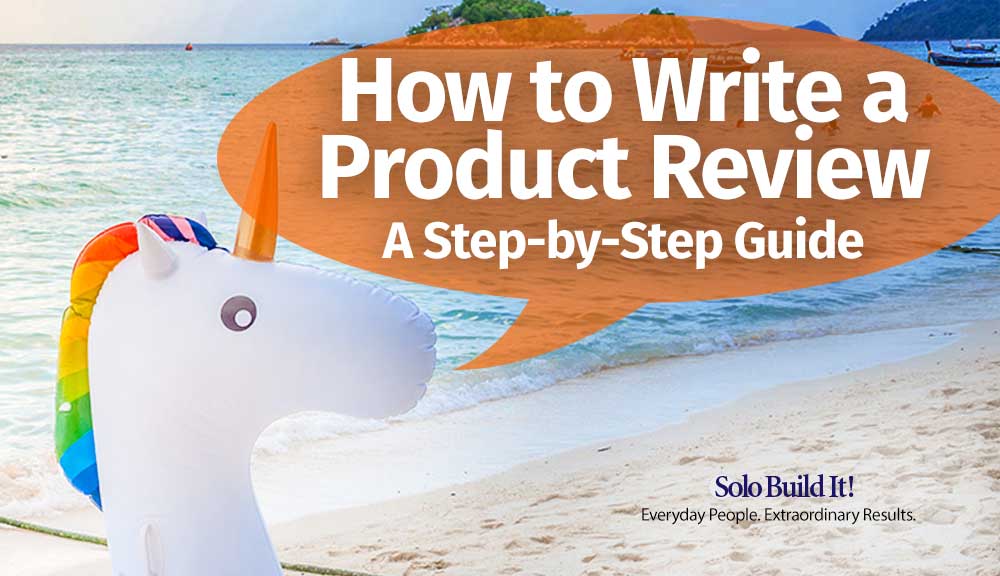
Learning how to write a product review is a valuable skill, whether you’re a solopreneur, affiliate marketer, blogger or even a student. If you want to sell products on your blog, grow your affiliate marketing sales, or pay your way through University, product reviews work — when they’re done right.
UPDATED FOR 2025
Have you heard of the term “fake reviews”? They’re reviews written with the sole purpose of selling a product, whether the product quality is good or not, even if the author has never used it.
This article is about how to write a product review, one that is authentic and offers your customers a solution to a problem, fulfills a need, or meets a desire.
Your product review page is not about selling to a customer. It’s about talking to a friend, offering the best quality information possible.
Check out how Nori paid her way through University with a travel site created with Solo Build It!.
Or perhaps you’re wondering if starting an online business is right for you, how much it costs and when you can expect the first earnings? We’ve answered the Top 10 Online Business FAQs for you here.
The process and techniques you’ll learn here apply to any product review: digital and hard products, affiliate products and your own; from the very expensive to the very cheap.
Before you start writing your page, you need to do some preparatory work.
Think of it like this: your customer is on one side of a door. To her, the door looks closed and barred. She has no idea how to get through it.

A good product review starts where your customer is, unlocks the door, and leads her through.
So before you choose the product you’re going to review and sell, you need to focus on what your customers need or want.
Not what you want. Or what you think they want.
Purchases are made for one of three reasons:
- to solve a problem
- to fill a need
- to fulfill a desire.
The impetus to buy is strongest if the issue is a pressing problem for which customers require a solution. It’s simply more acute, generally, than a desire.
So what we’re selling is more than a product or service. It’s
- a solution
- an outcome
- an experience
- a life-enhancer.
Two important things to understand about purchasing are that:
- it’s emotionally based
- people buy a product for the benefits it has for them — how it will directly improve their lives.
Step 1: Identify Your Customer’s Pain (and Write A Product Review to Solve It)
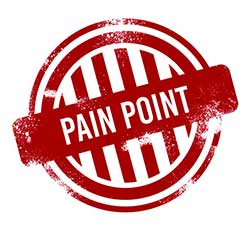 1. If you already have a product in mind, ask yourself:
1. If you already have a product in mind, ask yourself:
- What’s the single most pressing problem for your customer?
- If this isn’t about a problem, what’s her single most pressing need or heartfelt desire?
- How does this specific product help solve that problem, meet that need or fulfill that desire?
- What is the one main benefit of your product for the customer? How will it make her feel after she buys it? In what ways will her life be improved?
2. No product in mind at the moment? Even better. Ask yourself the same questions, in a slightly different way:
- What is your customer’s single most pressing problem, need or desire?
- What product can you offer — whether it’s your own or an affiliate’s — that will best solve that problem, meet that need or full that desire?
- What is the one main benefit of your product for the customer? How will it make her feel after she buys it? How will her life be improved?
3. No idea what your customer’s most pressing problem, need or desire is? Or think you may know, but you’re not really sure? Time to find out!
How?
- Ask in your newsletter, questionnaires, social media platforms, forums.
- Social media: what seem to be the most common issues for followers? Which questions are asked most often?
- Your own experiences with the product: what was your major problem when you started out? What would have helped you solve it?
Top Tip: Think Creatively
Think outside the box. Here’s an example.
Product Review Example: Identifying the Problem
I have a site about keeping backyard chickens. One of my most popular (and lucrative) products seems totally unrelated to chickens.
It’s an electronic rat trap. I sell upwards of 15 of them a day, and they cost around $35 each.
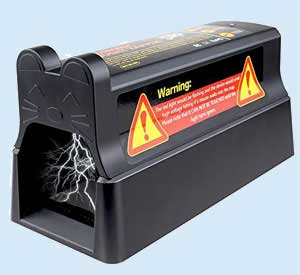
Why so popular?
I discovered that one of the most critical problems for chicken keepers is rats. Where there’s grain, there are rodents.
When I looked for solutions, I found many complaints about rats in the chicken run — but no long-lasting solutions.
So I asked for advice from some real live rat-catchers and wrote a series of articles: how to know if you have a problem, how to tell mice from rats, how to get rid of them.
Those pages all link to the product review page.
So, think creatively, particularly if you don’t have a specific product in mind. Find the most pressing problem. Find a solution. Write a product review.
Take some time now to note how you’ll identify the most pressing problem, need or desire for your audience. We’ll come back to this — it’s one of the two most critical parts of this process.
Sign up here to receive the how to write a product review worksheets to use for this exercise. Use it to record what you’ve discovered so far.
Step 2: Find the Right Words to Use When You Write A Product Review
We’ve identified what your potential customer’s problem or need is. Now we need to look at how she’s feeling about it.
Why? Because…
“Feelings + thinking = purchase.”

You’ll sell the product only after you’ve identified the pain point (or need) and let your customer know that you understand it.
So now we need to examine the kind of language she uses when she’s recounting her problems.
Using some of that same language makes your product review more likely to resonate. “This person understands exactly how I feel” is the reaction you’re looking for.
How to do this? Learn to speak the same language as your audience. Aim to foster rapport and credibility.
You already have your own “voice” for your blog or website. This is not about changing that voice. It’s about including some of the language — the specific words — your potential customers use to identify their pain points, and empathizing with them.
- Go wherever potential customers hang out to examine how people in your niche describe their problems, needs and desires.
- What exact words are used repeatedly to describe the problem (or need / desire) and how they’d feel if it were solved for them? What kinds of solutions are they asking for?
Don’t try to second-guess this. Avoid thinking that your customers “must” use the same language you do. The likelihood is, they won’t.
Sign up below to receive the how to write a product review worksheets to use for this exercise. Use it to record what you’ve discovered so far.
You’ll refer to your notes when you start to write a product review.
Product Review Example: Using Emotional Language
 Megan is a daycare provider. She has some fabulous books to sell — her own products — but she isn’t getting many sales.
Megan is a daycare provider. She has some fabulous books to sell — her own products — but she isn’t getting many sales.
Her books are about what to feed children in daycare. She had a sales page that described what the books were about — healthful, easy-to-make recipes, together with a shopping list for each one. If you want your recipes to get found in Google, make sure you are using proper recipe schema.
But the words on her sales page weren’t resonating with her audience.
So we looked for threads related specifically to food in a couple of daycare provider forums.
These are real quotes. Note the “feeling” words the providers use: “panicking”; “driving me crazy”; “at a loss”; “chaos”; “stressed out”…
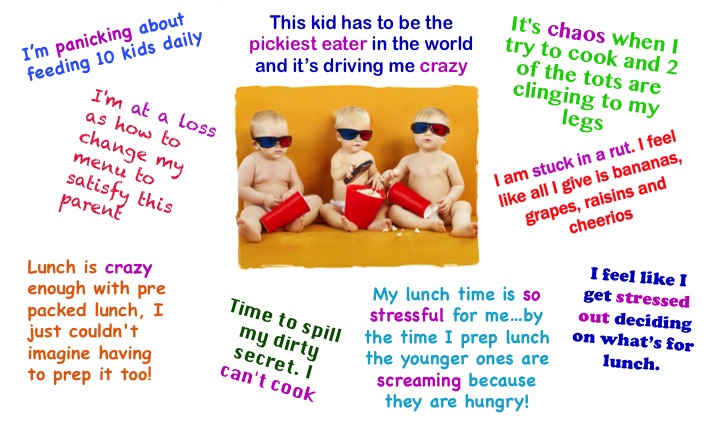
From the outside, some of it may seem funny, but to those daycare providers, it’s serious stress.
What’s the solution they’re looking for? Could Megan’s books be part of it?
Most of them really don’t know what they need. They’re expressing their feelings.
It’s the way they’re describing the problem that gives us a clue about where they are now and the emotional state they want to be in.
Reflecting these words back to the customer in her product review immediately resonated:
“Are you at a loss to know what to feed your daycare kids?”
“Does lunchtime feel like chaos, every day?”
“Feeling stressed out even trying to decide what to have for lunch?”
The feeling in her potential customer? “Thank goodness — someone who understands exactly how I feel!”
Now look at the flip side. Others in the same forum had a clearer view of how they’d like to feel and what the ideal solution looked like…
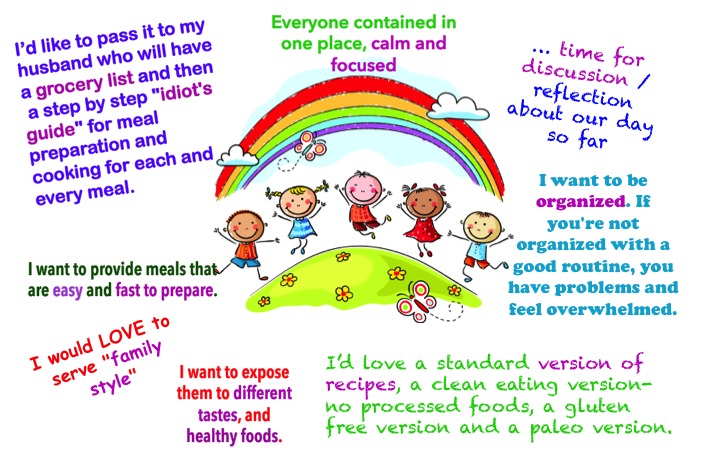
Again, notice the language:
“Calm and focused”; “time for discussion / reflection”; “organized.” And there’s the very idea for a product that Megan has already created!
How did we use this?
We put it together with the earlier “problem-focused” language:
“Are you at a loss to know what to feed your daycare kids?”
“Does lunchtime feel like chaos, every day?”
“Feeling stressed out even trying to decide what to have for lunch?”
“If you wish you could feel organized, calm and focused at mealtimes, if your heart’s desire is to be able to sit down, family style, and eat healthful foods with different tastes while having time for discussion about the afternoon ahead…”
“I have exactly the answer you’ve been looking for!”
This exact process can be followed to help you uncover the right language to infuse your product review with emotional impact.
It doesn’t always work out as clearly as this. Sometimes you have to dig more deeply. But the greater the problem, the more likely you’ll discover words that you can use to good effect.
And maybe you’ll stumble upon ideas for future products in the process.
 Does It Feel Manipulative?
Does It Feel Manipulative?
If so, reassess your thinking about products. You’re matching up problems your audience has with a solution they say they want.
That’s not manipulation. It’s serving your customers. You’re not going to sell them a product they don’t want. You are going to talk about the pros and cons — product drawbacks as well as benefits. You’re not going to deceive them about how the product will change their lives overnight.
You are going to tell them how your product, whatever it may be, can help change their world for the better — a little at a time.
Reminder: You are not writing a review with the primary goal of selling a product. Your goal is offering a solution, meeting a need or fulfilling a desire.
 As Solo Build It!’s Action Guide teaches, it’s all about the PREselling.
As Solo Build It!’s Action Guide teaches, it’s all about the PREselling.
Remember: Your product review is the door through which you lead your customer to the product you’re selling.
You’ll harness this and prove why this product is the one that solves her problem or satisfies her desire as completely as possible.
And your review won’t look anything like the reviews of scammers. It will look and sound like you, helping your customer.
Let’s examine the product you’re about to write a product review page for. How can we ensure that it provides a solution and meets your customer’s needs or desires?
Step 3: Choose Products to Review
 Remember the formula “feeling + thinking = purchase”? Here’s the “thinking” part.
Remember the formula “feeling + thinking = purchase”? Here’s the “thinking” part.
It’s important that this part — the factual information about the product — links back to the feeling part. That’s where our work lies now.
We’ll split this into two: products you’ve developed yourself, or have owned, used and love, and products you wish you had the money to try but haven’t.
Then we’ll look at smaller products, for which this process may feel like overkill.
Products You Use
Let’s start with your own products or affiliate products you’ve owned and used.
Use the worksheets you downloaded earlier. If you haven’t downloaded them yet, do it now!
It will be very important when you write a product review that you have this information at hand. So don’t just think about it — write it down.
Think through the benefits your product has.
If this is a product you’ve created yourself, or an affiliate link to a product you own and use, it’s a fairly straightforward process. You’re giving your personal feedback on the product: not just its features, but authentic information about how it helped you in real life. If you’re new to affiliate marketing, Miles Beckler covers “how to be authentically helpful” in his affiliate marketing crash course.
The worksheet allows for 5 features and their related benefits. If you can only think of 2 or 3, that’s fine.
If there are more, that’s also fine, but bear in mind you don’t want to overload your customer with information. What she’ll want to know most is how this product addresses her most pressing problem, need or desire.
Break this down into small parts.
- Are there other, similar products your customer has likely tried?
- What makes this particular product stand out above the others?
- What are its 3 – 5 best features? How did those features work for you? Are there any cons to this product’s features?
- If your product is a solution to a problem, what specific problem does each feature solve?
- Whether you’re addressing a problem, need or desire, what are the specific benefits of each feature? List them individually.
Your customer is more likely to buy a product if she can see its features as direct solutions to her problem or an exact match for her need or desire.
- How do each of those features meet the overall needs of your customers?
- Do those features meet the emotional needs of your customers?
- Will they help make her life happier, more relaxed — whatever she wants her life to be?
Case Study: Translating Product Features Into Benefits
I have a website about Italy, which is where I live. I sell a lot of electric pasta machines on my Italian site.
 My Italian friends cannot believe that anyone would want to buy an electric pasta machine at relatively high cost when a bowl, a table and a rolling pin do exactly the same job at less than one-tenth of the price.
My Italian friends cannot believe that anyone would want to buy an electric pasta machine at relatively high cost when a bowl, a table and a rolling pin do exactly the same job at less than one-tenth of the price.
But the most obvious, and best, feature of the pasta machine is that it automates the process. Flour, egg and water go in. 35 minutes later, push a button and pasta comes out the other end.
And the greatest benefit is one we can all relate to: a saving of time. A working parent of two toddlers may want to give the family fresh pasta for dinner, but time is against her.
What does she feel about that? Perhaps frustrated. Guilty that she’s not able to be a “perfect parent.” Tired, if she tries to make pasta anyway… Stressed, because (at least in her mind) other parents seem to manage to provide healthful meals every day.
How does she want to be? Relaxed. Happy that she’s providing nutritious meals. Glad that her children are learning about, and eating, food that’s not processed.
What solutions does the pasta machine offer, and how will they help make her feel good?
- The #1 benefit of automating the pasta-making process is that she has more time to spend with her children.
The added, less obvious benefits? Perhaps improved relationships with the children. A more relaxed household.
- A second benefit is that she’s able to feed them nutritious meals that taste good (after tasting really fresh pasta you never want the dried sort again) and have no additives.
The benefit of that is for her entire family: healthier food means healthy children, an improved lifestyle.
Which may mean fewer doctor’s visits, less time off school, less stress…
And then there are lessons for children about preparing food with fresh ingredients…
See how each separate feature can lead to multiple indirect benefits, many of them emotionally based, which all lead back to how our customer wants to be?
Acknowledge the Negatives
Very few products have absolutely no drawbacks at all, and it’s important to acknowledge that when you write a product review.
Why? Because there are too many fake reviews out there that praise products, mentioning no drawbacks. That’s doing a huge disservice to customers — and will dispel any trust you’ve built up.
So, be honest.
 As well as thinking about the positives, consider whether there are any negatives in the product. It may be a missing feature, or a high price. It may be something very specific to the product: for one of my chicken incubators, for example, it’s the fact that high humidity causes some of the moving parts to rust.
As well as thinking about the positives, consider whether there are any negatives in the product. It may be a missing feature, or a high price. It may be something very specific to the product: for one of my chicken incubators, for example, it’s the fact that high humidity causes some of the moving parts to rust.
If you’re reviewing your own product and it’s already live, look at what your customers are saying. If they’ve not said anything negative, ask them. Questions like “how do you think this product could be improved?” or “what’s the one thing you’d change about it?” are a good starting point.
If it’s an affiliate product and you can’t think of any cons of the product, look at some reviews. Amazon is a rich source of information. Review all the reviews: one or two stars are the obvious ones to read but sometimes reviews of 3 or 4 stars can give more nuanced problems people have come up against.
Are those issues going to stop your customer from getting through that barred door? Are the drawbacks enough to put her off buying the product?
Take some time to think about your product drawbacks. How could you overcome them?
If you draw a blank, look for reviews from people who’ve used the product and found it lacking but have overcome the obstacles. Are their solutions something you could also offer to your customer?
What If You’ve Never Owned the Product or Tried the Service?
Writing about a product we own and love is obviously the best type of review. But we don’t always have the luxury of testing every product we think will meet our customer’s needs. I don’t have the money, the time or the inclination (well — maybe the inclination…) to try out all of Italy’s best hotels to review for my site.
So, what then?
 Ask other people.
Ask other people.
Occasionally we can do this in person. Friends or family may have tried it. Sometimes we can ask our most trusted customers. What can they tell us?
Be careful about this. People’s memories can be selective, and individuals have differing ideas about what’s a necessary feature. Not everyone thinks having six kinds of tea in their hotel room is critical to their enjoyment of Florence.
Sometimes we don’t have either of those options. In that case, our option is to look at other people’s reviews.
This one is tricky. Earlier, I mentioned “fake reviews.” Amazon, Yelp and TripAdvisor have struggled with them for years.
Why? Because reviewers have written reviews not to offer help to prospective customers but to make competitors look worse. It’s particularly prevalent in the hotel and restaurant industry.
Amazon and Expedia have become better at preventing fake reviews. They highlight those from people who have bought the product or stayed at the hotel. They’ve also prosecuted when they’ve found proven fake-ness — but the problem is still there.
So, what should you look for if you’re curating other people’s reviews for your page?
- A phrase like “verified purchase” or “by a verified traveler” is a good place to start.
- This kind of comment may seem honest:
I received this product for free or at a discount in exchange for my honest, unbiased review.
The intent may well be genuine, but research shows that even with the best of intentions, people who receive goods in return for a review tend to be less critical and more positive, and they give a higher rating than others. (See, for example, this study). Be careful of this type of review.
- Look for reviews with personal photos. They usually confirm that the person has used the product, stayed at the hotel, eaten at the restaurant.
- Don’t just look at 5 star or 1 star reviews. Check the middle ground. Very few products have no flaws at all, very few are utterly dreadful.
- Search for reviews that tell a personalized story. Some people relate how their family uses a product, or why their dog hates a particular squeaky toy and goes for slippers instead.
Is This Tantamount to Writing a Fake Review?
Is this a manipulative way of writing a review? Some say it is. Clearly, having personal experience is the ideal.
But this is the real world. Do your research thoroughly and make clear in your review that’s what you’ve done.
Whatever else you do, do not, ever, make things up to suit your needs.
Your customer will trust your ideas, knowledge, passion, technique and understanding to make a difference to her life — to unlock that door and lead her through to a more contented life.
Abuse that trust at your peril.
What About Small Items?
Is it really worth going through all this for a $9.99 ornament from Amazon?
Let’s take another real-life example.
Case Study: How to Review Products with Low Price Points
 I love Christmas decorations and enjoy writing about them. But the fact that I love them doesn’t mean that everyone will. Unless I discover why people in my niche like to buy them (as opposed to why I like to buy them!).
I love Christmas decorations and enjoy writing about them. But the fact that I love them doesn’t mean that everyone will. Unless I discover why people in my niche like to buy them (as opposed to why I like to buy them!).
One of the most successful small affiliate products on my Italian site is a $20 snow globe. I sell dozens as soon as we get to August.
Why so successful? It’s not a problem looking for a solution, after all.
It’s successful because it’s hand-made in Italy. It’s robust enough to become an heirloom. And I know this particular section of my Italian site’s audience: they’re very proud of their Italian roots, and keen to keep those roots alive for their children and grandchildren.
So that’s where my product review page starts: with an appeal to emotional ties to Italy:
Looking for a unique and relatively inexpensive Christmas gift, hand-made in Italy, that can be passed down your family for generations?
Whatever the product you want to review and sell, it all comes back to that same issue: put yourself where your audience’s emotions are. Use language that resonates and find a solution, or an item that satisfies their need or desire.
In terms of how much time to devote to researching and writing about smaller items, give as much or as little as you think your product is going to merit. Your $500 course will need more research than my $20 snow globe.
Let’s Summarize
If you’ve completed the tasks and used the how to write a product review worksheets, you now have the background material to make writing your review a straightforward process.
You have invaluable information about…
- What your potential customer’s pain points, needs or desires are, and the language she uses to express them.
- How your product can become the key that offers a solution, meets a need or fulfills a desire.
And you know that…
- When you write a product review, you’ll concentrate on how its features can bridge the gap between where your customer is now, and where she wants to be
Step 4: Time To Write A Product Review
It’s time to write your product review. Here’s what you’ll do:
- Choose a keyword
- Create a main headline
- Draft subheadings
- Write the content
- Find images, testimonials and ratings to include
- Write the call to action
1. Choose a Keyword
 Solo Build It!’s keyword brainstorming tool can help you research the most popular keywords.
Solo Build It!’s keyword brainstorming tool can help you research the most popular keywords.
2. Create the Main Headline
8 out of 10 people who click across from search results will read your headline. But only 2 will read the rest.
That’s how important your headline is.
The aim is simple: to get the customer to read the first sentence.
Your headline writing must be compelling, suggesting something the customer will find of great value.
Refer to the information you’ve gathered in your how to write a product review worksheets, because your headline must address your customer’s biggest problem, most desperate need, or most wanted desire.
That’s what will make her read on!
A question (to which you know the answer will be “yes”) is a good way to start. And it doesn’t need to be complicated.
Remember I mentioned that one of my best-selling products is rat traps?
“Got rats?” is all I use for the headline of that product review. It’s all it needs, because people who have the problem instantly react.
Suppose you’re offering a program for your customer to cut down on her sugar intake. If you know that what she’s searching for is “sugar detox” then the question “Been eating too much sugar recently?” will hook her.
3. Draft Subheadings
Your subheadings also need to demand attention and convey value. They have a double imperative: to make clear why the text below is a must-read, and to stop your customer from scrolling endlessly — and leaving the page without buying.
Why are subheadings important?
They break up the text, and make reading much easier. They also help keep your reader’s eye moving down the page.
Specifically, each subheading must relate to one of the benefits you identified for your product.
Remember: this is an outline. You can alter it if the subheadings don’t seem to fit once you start writing.
Creating them now will help keep your product review highly focused.
4. Write the Content
Your First Paragraph
 The first paragraph is the most important in the entire review. Your customer will decide that either you understand where she’s at and can do something to help, or you have no idea and she should look elsewhere.
The first paragraph is the most important in the entire review. Your customer will decide that either you understand where she’s at and can do something to help, or you have no idea and she should look elsewhere.
It’s your job to make her not just want, but need, to stay on the page.
So grab your reader’s attention by appealing to her current emotion(s) — noted in your worksheet — and expand on the promise you made in your opening headline.
Once you have her emotional attention, she’ll give you her intellectual attention so that you can lay before her all the benefits of this product that will make her life easier.
Your headline referred to her main problem. Now tell her that you know how she feels, and that you know of something that can help. Start to lead her through that door she thought was locked.
Tell her what’s in the page for her. Give a clue here as to what the product can do to solve her problem or meet her need or desire.
Focus on those people who are likely to buy your product. (That focus will likely put off people who are never likely to buy it.)
So, go back again to your worksheet notes. What’s the biggest benefit you noted? There’s your first sentence.
Case Study
Here’s an example (Where the headline is “Got Rats?”).
“This electronic rat trap is strong enough to help keep your chicken coop free from rodents — permanently.”
Problem (headline) = rats. Answer (first sentence) = this amazing rat trap. End result: I will help get you, my potential customer, to where you want to be: rat free.
Don’t over-promise. People need more than a rat trap to keep rats away — note the words “help keep.”
See how things fall into place when you’ve done the prep work? Simple, right?!
Refer to your worksheets. Note which words you could use, and the main problem / need / desire you referred to in your worksheet.
Now write your opening section.
- Address your customer’s main problem, need or desire. Focus on the one most important benefit.
- Refer to how she may be feeling. Use the words you discovered that she uses.
- Tell her that you understand where she’s coming from because you’ve been there too (if you have!).
- Summarize why she would find this product of help. Research has shown that using the word “imagine,” if you can do so without forcing it, helps the customer picture how her world could change. Your aim is to make her imagine how her world could look if she used this product or service. Help her to visualize the experience.
This opening section will lead into the remainder of the page, which will describe the benefits — and possible drawbacks — of the product.
The Rest of the Content
General Tips
- To be effective, your review must focus on your customer, not on you. Seth Godin calls this “the only radio station people care about — “WII-FM,” aka “What’s in it for me?”!
- Do not start your review page with the price of the product. Talk first about the specific benefits, until your customer feels she has no real option but to buy your product.
- Remember: you’re not writing a thesis or a scholarly report. The way you learned to write at school or college is not the best way to connect with people, unless you’re in a scholarly niche.
- Keep sentences short. They’re easier to read and understand, and they improve the rhythm of the page.
- Don’t worry about starting sentences with “and” or “but.” If that’s the way you would talk to the customer if she was sitting in front of you, use it.
- If you want to really draw attention to a particular feature, try adding in individual words. Take an example from Apple’s ad for the iPhone X…

- The Hemingway App is a great free tool to examine your content. Don’t click on the green button, just delete their text from the page and paste in your own. If you’ve never used it before, you’ll be surprised what comes up.
Don’t feel you have to satisfy it completely though — sometimes it can tell you to do weird things. Use your judgment and your knowledge of the style your customers like.
- Write so that the potential customer feels like you completely understand her situation — you’ve been there, done that, found the solution / fulfilled your need or desire. Remember, your overall goal is to make her think “Yes! That’s exactly how I feel! This is exactly what I need!”
- Finally, remember the mantra about not writing a sales page.
Don’t sell to a customer. Talk to a friend.
Your content sections are now more or less written for you, based on the information you gathered in the worksheet.
Write your product reviews when you’re feeling energetic and positive. Those feelings communicate themselves in our writing.
If you feel unwell one day, schedule your review for the next. But do not use this as an excuse to avoid writing at all! Every day you put off writing is a day’s potential income lost. It’s important to develop work habits and regularly make time to sit down and write.
Here’s what you’re aiming for:
- “I feel your pain” — reflecting where your customer is.
- “I understand” — been there, done that, know where you want to be!
- “I bet you’ve tried this” (if you know from your research that she’s likely to have tried other products, which haven’t helped).
- “My solution worked” (or “my / other people’s needs were met”) — a story expressing a belief that your product can help.
- “Here are the benefits of this product and exactly how it can help.”
So: take the worksheet, use some of the vocabulary your potential customers were using — particularly the emotive words — and go through each product benefit you highlighted.
After you’ve written each section, read it and ask yourself…
- Why should anyone read this?
- Am I falling asleep reading this?
- Do I actively want to read on to the next section?
Case Study: How to Write a Product Review Outline
Here’s the outline of my rat trap product review, told in pictures.
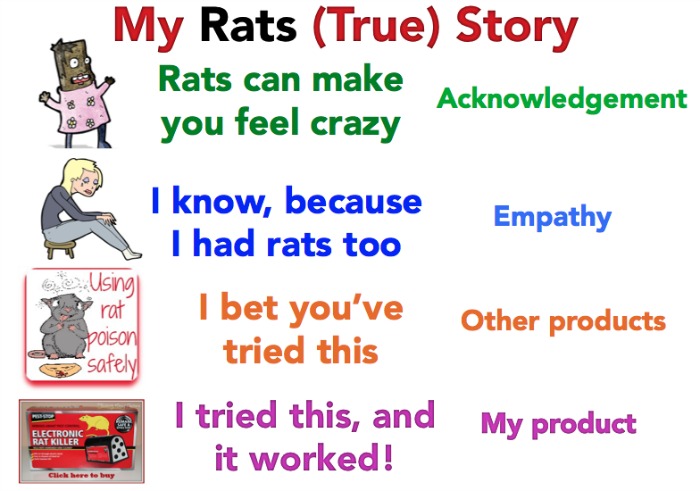
And these were the three main (emotional) benefits I told my potential customers they might expect:
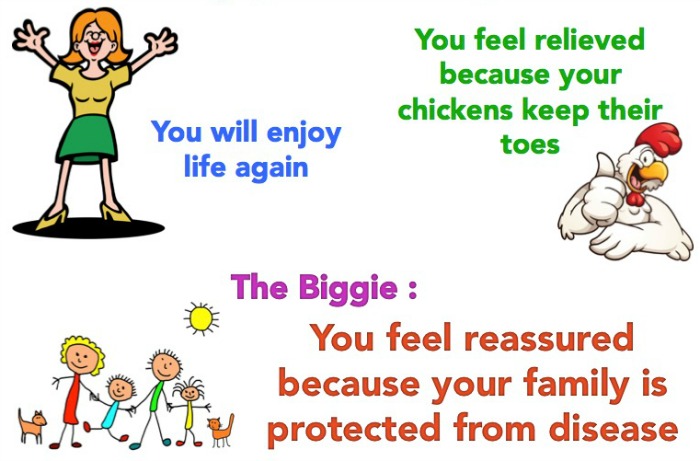
What If You Haven’t Tried the Product?
We looked at this issue earlier. The same principles apply in the opening section:
- Refer to the main problem, need or desire.
- Consider how your customer may be feeling.
- Tell your customer that you’ve done research to find out what’s most helped other people.
- Summarize why they found this particular product of help.
5. Find Images, Testimonials and Ratings
Images
Although you’re communicating key messages in your headlines, subheadings and text content, images can help sell a product. They help break up the text, they provide an emotional connection, and they show what the product looks like and how it works.
 Product images are always good, and if you can include yourself in the image unpacking, assembling, holding or using it, so much the better. It helps create that personal connection — and shows it’s an authentic review.
Product images are always good, and if you can include yourself in the image unpacking, assembling, holding or using it, so much the better. It helps create that personal connection — and shows it’s an authentic review.
Be creative! Do you make and sell your own products or provide a service? Take a photo of you painting / quilting / cooking / dancing / counselling / with a patient (don’t want to ask permission? Get your partner to play the patient, sitting with back to the camera so the focus is on you).
Remember: images are not only photos. Research shows that about 90% of customers say that video helps them make purchasing decisions, and roughly 64% say that they’re more likely to buy a product online after they’ve seen a video of it.
Not able to make your own video? Check YouTube for an excellent video of the product in use and embed it in your sales page.
If you don’t have your own image of a product you’re selling from an affiliate, use theirs. If you’re not sure about copyright, write and ask.
What if your product doesn’t lend itself to an image — for example, a Kindle book, or an online course? Share part of the product itself. You can do this by either allowing access to (for example) the first chapter / lesson, or by telling people in detail what it includes.
Testimonials
Testimonials are particularly important if you’re selling your own product, and useful if you’re selling an affiliate product.
Use testimonials to counteract any issues you found in the research stage that may reduce the likelihood of purchase. An example might be that it’s too expensive: find testimonials saying “Yes, expensive — but so worth it!” or “You get what you pay for.”
Many affiliate marketing programs include resources to help you in writing about their products. Take some comments from the “review” section of the affiliate company’s site. State that’s what you’ve done — something like “Here’s what some people who’ve bought [the product] on [Amazon] are saying.”
Building brand loyalty through genuine testimonials can significantly boost your product’s credibility. For your own products, it’s particularly important that you make clear that these testimonials are not made up! Yes, it happens a lot, and potential purchasers are wary of “fake reviews.” Wherever possible, ask customers if you may use their full name and a photo. The more detail you can add, the better.
Ratings
Companies like Amazon and Expedia give stars when you review their products. It helps potential customers quickly know whether or not you’re recommending the product.
 Why not add this feature into your review? Decide on how many “stars” the item you’re reviewing merits — and be honest about it. If you think it merits five, go for it, but don’t be afraid to score it lower. Remember: people can become suspicious of reviews that have no negatives.
Why not add this feature into your review? Decide on how many “stars” the item you’re reviewing merits — and be honest about it. If you think it merits five, go for it, but don’t be afraid to score it lower. Remember: people can become suspicious of reviews that have no negatives.
6. Write a Product Review Call to Action
You’ve written all your text, added your images, testimonials and rating, and now you’re ready to publish.
Except… you need a Call to Action.
Tip: Brush up your CTA writing skills with these Call to Action best practices or look at some real life CTA examples that work.
At the end of your review, remind the customer about the benefits she’ll get when she buys and how the pain or inconvenience will go away when she buys, or how amazing she’ll feel when she has that lovely picture hanging on her wall.
 If you have your own product, consider reducing risk by offering a guarantee. People are terrified of being scammed and taken advantage of on the internet. A guarantee can take that burden off their shoulders. And the good will you’ll get will far outweigh the actual costs in the longer term.
If you have your own product, consider reducing risk by offering a guarantee. People are terrified of being scammed and taken advantage of on the internet. A guarantee can take that burden off their shoulders. And the good will you’ll get will far outweigh the actual costs in the longer term.
Once you’ve done that, ask them explicitly to buy. You don’t have to do a “hard sell.” If it’s your own digital product, invite people to “download now,” for example. If it’s an affiliate product, invite people to click over to the company’s site if they need to see more reviews.
And Finally…
Congrats! Not only have you learned how to write a product review, but you’ve created a product review template that you can use time and again.
Before we finish, here are some wrap-up reminders:
- What if you write a great review but get no sales? Test, test, test! Ask your colleagues, family, friends, and your audience in your newsletter or social platforms what they think of the review. Your aim is not to get them to buy, necessarily (although they might!) but to see what they genuinely think.
- When you’ve finished your page, look at it in preview and read it aloud. Does it sound good? Does it flow? Would you be persuaded to buy?
- Put yourself in the shoes of your customer and her problem, need or desire. Have you led her through that door she felt was barred to her forever, to a place where she feels she has genuinely been helped to a happier life?
- Finally, probably the most important question to ask yourself when your article is written is this one: have you sprinkled enough unicorn dust over the content to make it a truly magical experience for your reader? In other words…
When you look at this product review page, are you proud of it?
If your answer is a resounding “yes!” then it’s a big “Congratulations” from me — your product review page is finished.
Learn how to start a business online and earn extra income on the side.
Questions about how to write product reviews as part of your online business?
Message one of our friendly Advisors right away
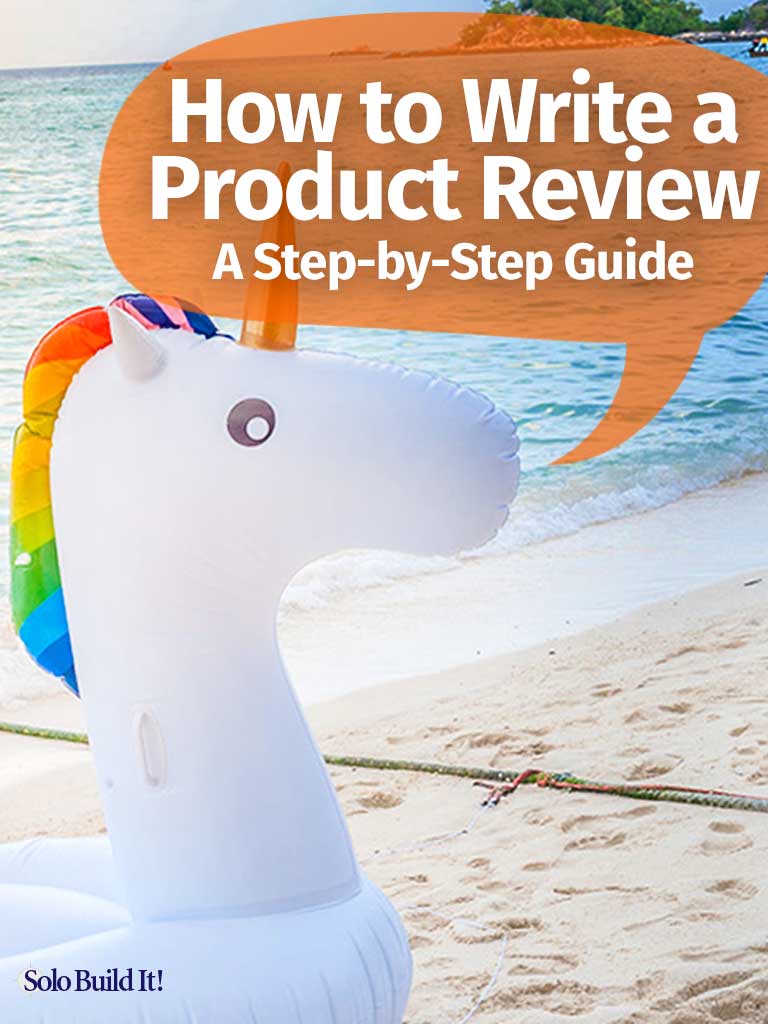
Cath Andrews
Latest posts by Cath Andrews (see all)
- Start a Passion-Based Business and Live Your Dream - February 1, 2023
- What Do You Say When Their Eyes Glaze Over? - December 20, 2021
- How to Monetize Your Email List in 5 Simple Steps - October 26, 2021


